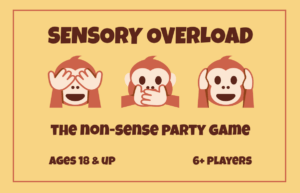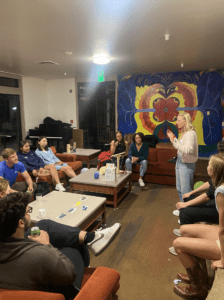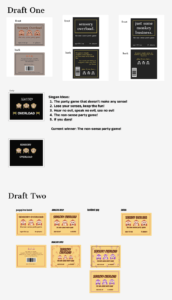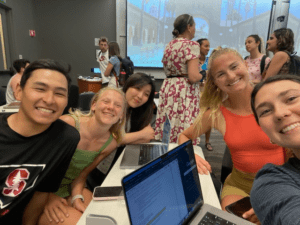
By Jeong, Tara, Maya, Emily, Wesley
Artist Statement
Whether you don’t know anybody at the party or you’re hosting an intimate game night with close friends, “Sensory Overload” is laughter in a box. A spin on round robin party games like For the Girls and a folklore favorite Truth or Dare,
Sensory Overload eliminates the social vulnerability associated with sharing “Truths”, reduces the creative burden of coming up with funny “Dares” and gets everyone at the party up and out of their seat, interacting with one another. With a clever team vs. team game board design, players form fellowship in their teams and have motivation to complete the Dares to win.
It’s the non-sense party game for a reason. Each card manipulates one of the players’ senses, such as hearing, sight, balance, smell, and feel, by removing or augmenting players’ ability to hear, see, and speak. With a cheerful, colorful theme, the “hear no evil, see no evil, speak no evil” monkeys guide the players through sensation-based fun. Other than the game kit, only two household supplies are needed – a pair of headphones and a timer.
So crack open the box and get ready to play… if you dare.
Concept Map

Initial Decision and Formal Elements
In the early stages of designing our game, we were guided by a vision to create an engaging experience that fosters fellowship, challenge, and friendly competition among players. This immediately guided us towards a Team vs. Team player arrangement, as it would not only promote stronger relationships within each team but also create opportunities for interaction with members from the opposing team. We also believed that this would enhance the game’s competitive dynamics, motivating players to actively engage and care about the game’s outcome.
Another key early decision was the introduction of randomness through a dice roll mechanic. Initially, the dice roll was only meant to determine the dare type each player would receive, but it later became an integral part of the game board and movement mechanics. This decision ensured that each game would be unique and unpredictable, adding to the overall excitement.
As we continued refining the game, we also reconsidered our approach to the game’s objective. Our first concept involved a collection mechanic, where teams had to gather a specific number of cards to win. However, we noticed that this approach caused confusion and lacked the clarity we desired for our game. To address this issue, we shifted to a race-based objective, with players advancing along a game board containing squares associated with various dare cards. This new objective allowed us to maintain the randomness of the dice roll, while also enabling players to visually track their team’s progress in comparison to their opponents.
Throughout the process, we focused on the values of fellowship and challenge as the primary sources of fun. By incorporating these values into the game’s mechanics and objectives, we hoped to create a game that would strengthen friendly relationships among players and provide engaging obstacles that teams would need to overcome together.
Testing and Iteration History
Possibly the most important part of this entire process has been playtesting with peers and friends. As a team of 5, there were a ton of ideas and conversations surrounding what might be the most fun for players. It was only when we playtested that we realized what parts of our game needed improvements, and what parts of our game we decided to keep.
April 20, 2023 – Playtest with friends
In this playtest, our team invited friends over to Jerry lounge to play our game. We had 14 playtesters in total. 
What worked:
- People seemed to be having fun and laughing throughout the game.
- The rules were relatively easy to understand, and there was a low barrier of entry to playing. Setup was quick, and we got the game running in a few minutes.
- Dares that removed sense of smell and sight were especially fun for the players.
What didn’t work:
- No clear way to start the game.
- For some dares, it wasn’t clear what sense it was removing. Some dares actually depended on the sense it was supposedly “removing,” which confused players.
- Some dares incorporated two or more senses. This was okay with us, but it was confusing when it came time to sort the cards by sense. Some players were also unsure of what sense was being removed, and had to read the card multiple times.
- Cards that required players to close their eyes were worded in a confusing way – they needed to close their eyes, but they also needed to be able to read the card, but they also needed to make sure not to read it aloud. This would’ve been a perfect opportunity for a partner to come in, but it was not clear who to choose as a partner, and how to incorporate them into the dare.
- Some folks felt uncomfortable doing the dares in front of people they’d never met.
- There was a lack of cohesion to the game. It wasn’t clear what the “win” factor was, as it seemed like the game could go on forever.
- Players didn’t feel like they knew their team members better by the end of the game, nor did they feel as though they’d built trust with one another.
- The most popular dare was one related to the sense of hearing. The player who picked the card had to let someone from their team choose a random person to call from their contact list while the player plugged their ears. The player had to keep the conversation going while their partner acted out what the person on the other end of the call was saying. Unfortunately, we didn’t actually see this dare happen, as a number of things went wrong: the dare wasn’t worded clearly, there was no cell service on the player’s phone, and when we did get cell service, the person they called didn’t pick up. This gave us insight into the types of dares that people enjoyed, however.
Changes made after this playtest:
- We categorized the dares more clearly. We also realized that most of the cards were related to seeing, hearing, and speaking. Upon noticing this pattern, we pivoted from a game that removed all five senses and instead manipulated one’s ability to 1. see, 2. hear, and 3. communicate. Instead of writing dares that remove a sense, change to manipulating or tied to a sense. This gave us more flexibility and clarity within the dares.
- Previously, it was unclear how players won. We introduced a game board to address this confusion, so that teams were set up to work towards a cohesive goal.
- At first, we used a colored dice. Each sense (hearing, sight, touch, smell, taste) had a color associated with its category of dares. The color that the player landed on, would determine from which card deck the player would pick the dare from. However, this turned out to be a mess! For one, there were too many colors on the dice than there were senses. Secondly, some colors didn’t match up with the colors we used to categorize the dares. Overall, it took more time clarifying how a dare was chosen and what a player had to do to successfully complete the dare, than the time it took for the player to do the actual dare itself.
April 25, 2023 – Section Playtest
Before our playtest in class, our team split up into two teams of two while one of us moderated. This was our first time trying out the game with our fresh new game board.
What worked:
- The wording of the dares was a huge improvement from our last playtest.
- It was generally easy to understand and attempt each dare, and most of the dares felt like the appropriate level of difficulty.
What didn’t work:
- We tried a new method of determining who starts the game: one person from each team says, “Ahh!” for as long as they can. Whoever gives up first has to go first. However, we realized this method wasn’t as efficient as we would’ve liked. We realized there might have to be a different way to decide who starts the game.
- We couldn’t complete some dares (e.g. telephone charades) because we had too few people. We realized a minimum of 6 players (3 players on each team) was ideal for gameplay.
- A few dares were still unclear, which we discarded before the playtest in class so as not to confuse our classmates.
- The figurines that are used to move across the game board covered the type of monkey that it landed on.
What we changed:
- We discarded a few cards because they were unclear or too easy, and noted which ones we wanted to improve the wording of. This was important to us because
- We noted that we would need to supply clear figurines or tokens to denote a team’s progress in the game.
April 25, 2023 – Class 4A Playtest
We playtested with our classmates! We had six playtesters total.
What worked:
- The game board was a great idea, as it was a visual representation of what teams were working towards.
- The phone call challenge that epicly failed in the previous playtest ran successfully in this playtest! And people loved it!
- People also loved the dare which had a partner pick someone from their followers on Instagram to like the 15 most recent photos of.
- Playtesters filled out a google form that we created to tell us what they liked and disliked. They also had space to tell us what type of dares they’d like to see be included in the game.
What didn’t work:
- The game board was a little plain and small. One player commented that they had wished they landed on a square with one of the monkeys on it, when in actuality they landed on a blank square. They had wanted to complete a dare instead of getting to a square safely.
- Players were confused with the punishments and wanted more clear instructions on how many spaces to go back.
- Players felt too uncomfortable doing the macarena in front of someone else. They commented on how this game would be best played with those you already know well.
- Players wanted the dares to be face-down as they picked them. However, we couldn’t do this as our icons to note whether a card manipulated seeing, hearing, or speaking was on the front of the card.
- A few dares were still confusing to read (e.g. “try not to laugh challenge”). Some dares took too long to read.
- There weren’t many dares related to sense of sight.
Changes made after this playtest:
- Change the color and typography of the game box to a more vibrant and warm-toned one to evoke excitement and fun.
- Refine prompts to ensure that they stick to one of seeing, hearing, or speaking.
Summary of iterations
Iteration 1 (first ideas for the game, no playtest): Our first version of this game came from the brainstorm session in section. We all loved the idea of a fish bowl game (a game where a bunch of pieces of paper are put into a bowl) and Truth or Dare.
 Iteration 2: As we worked on our project more, we decided that we needed some “it” factor: something to differentiate it from its two parent games (fish bowl game and Truth or Dare). We decided that a fun way to switch things up would be to limit the senses during the dares. We wanted to have some sort of sense die, where when it landed on something like “sight” or “hearing” you could not use that sense during the dares. When we started working on formal elements in class, we came to the conclusion that our game would be a bonding game: the game you play to get close familiar enough with other people to play Truth orDare. We called it: Trust and Dare.
Iteration 2: As we worked on our project more, we decided that we needed some “it” factor: something to differentiate it from its two parent games (fish bowl game and Truth or Dare). We decided that a fun way to switch things up would be to limit the senses during the dares. We wanted to have some sort of sense die, where when it landed on something like “sight” or “hearing” you could not use that sense during the dares. When we started working on formal elements in class, we came to the conclusion that our game would be a bonding game: the game you play to get close familiar enough with other people to play Truth orDare. We called it: Trust and Dare.
Iteration 3: After our playtest with our friends, we realized we needed to pivot. We couldn’t force a group of people to build trust among one another. We introduced a prototype of a game board, refined our dares, and tried this version ourselves.
Iteration 4: We enjoyed using the game board as a way to visualize progress and competition. We felt good about pivoting from a game of “trust” to a game centered on Fellowship and Sensory fun. When we playtested with our peers in class, players completed embarrassing challenges towards a common goal, and it was evident that there was a clear theme to the game that we didn’t have before. By focusing on what type of dynamic we wanted to create among players and centering our dares on seeing, hearing, and speaking, we developed a final version that seamlessly facilitated teamwork and communication.
Final Prototype
Final Mock Up
Final Mockup & Physical Version
Video
Thank You




